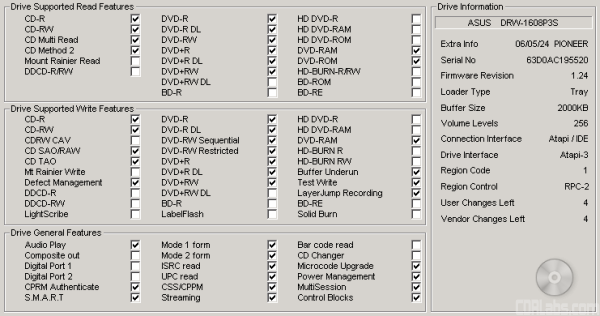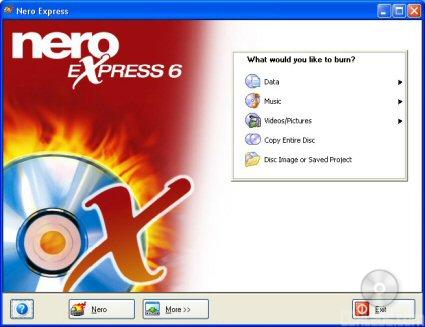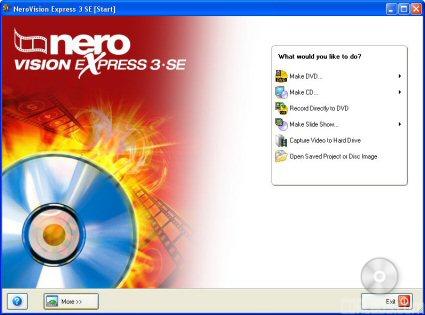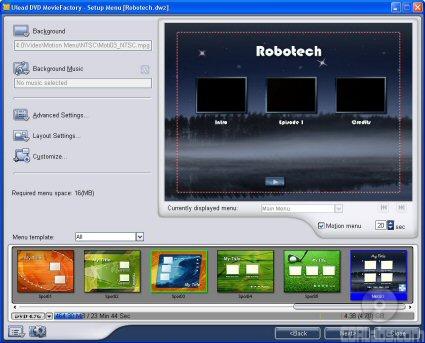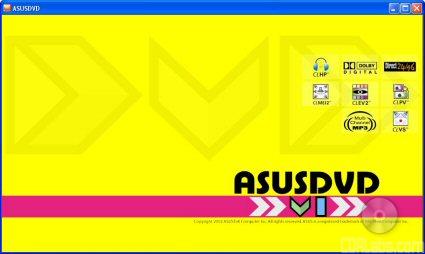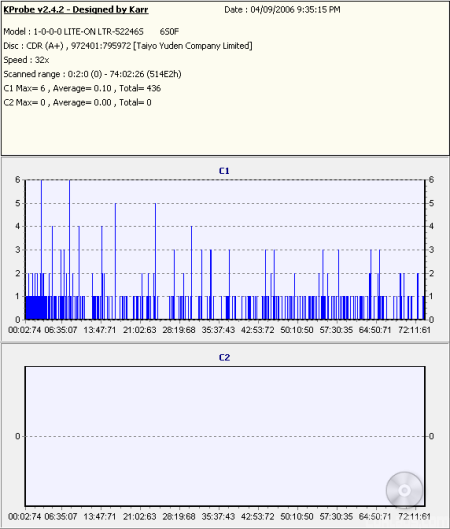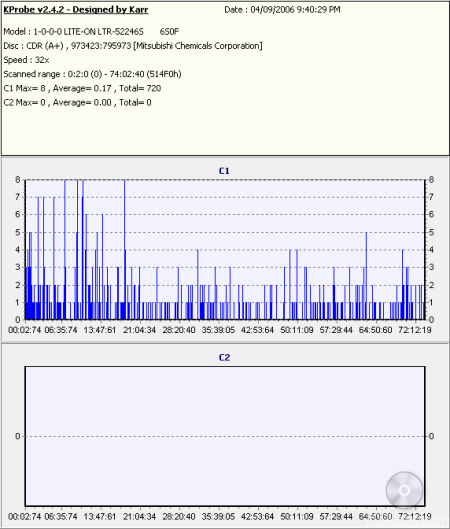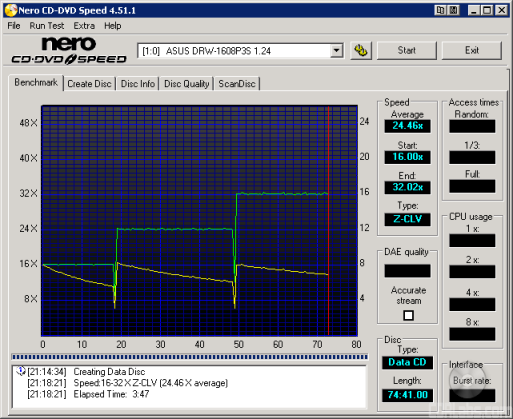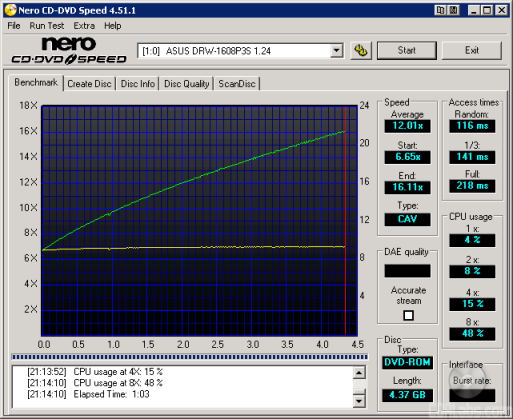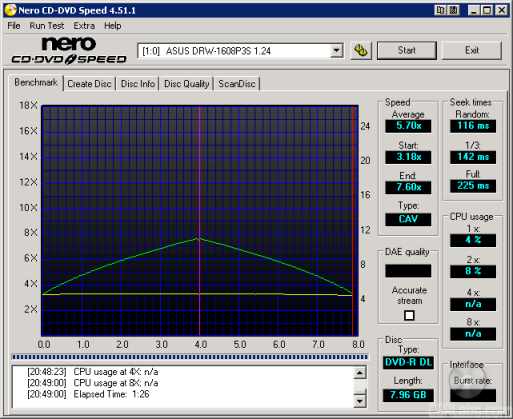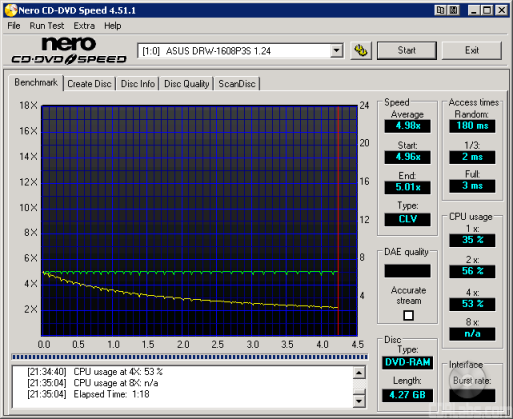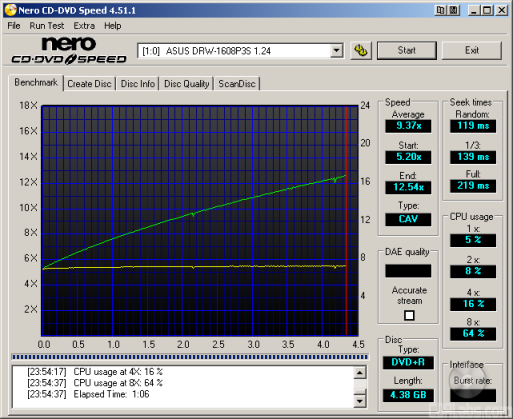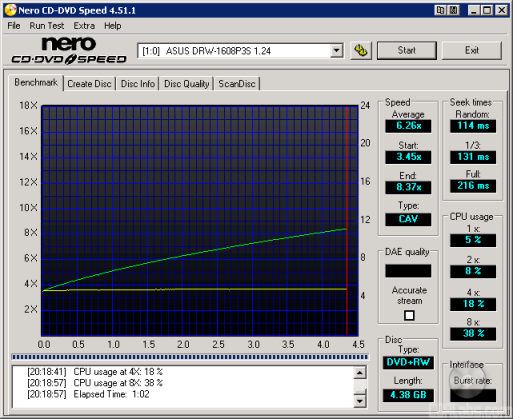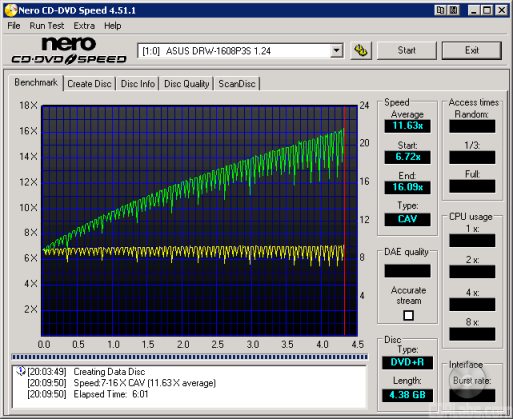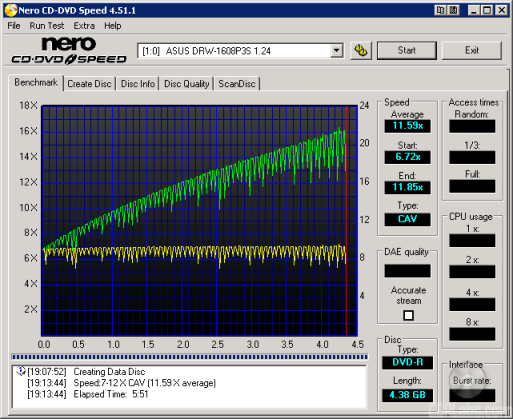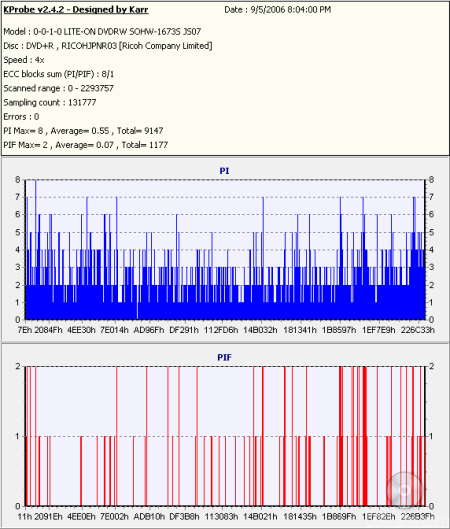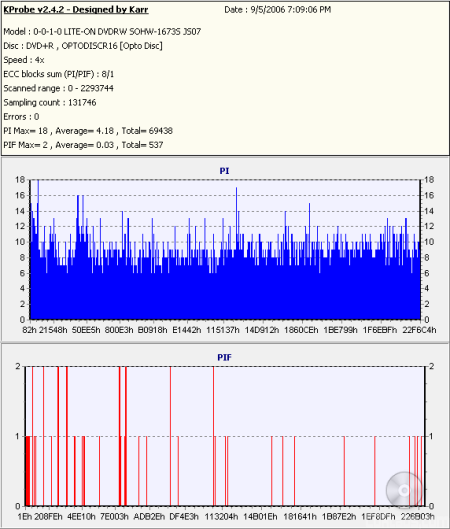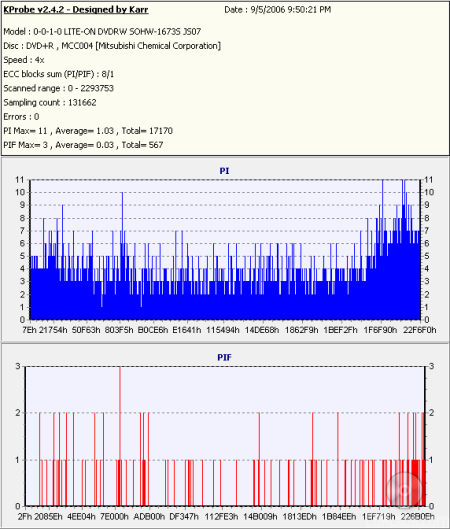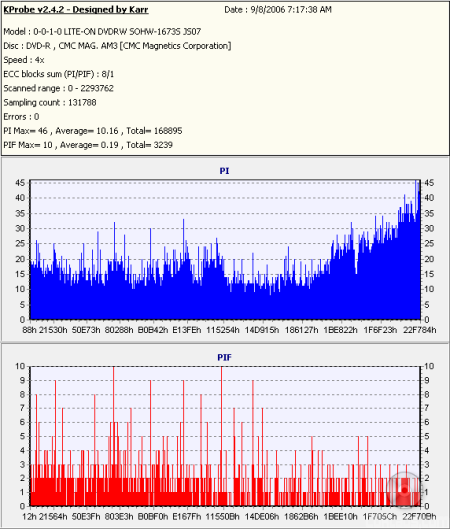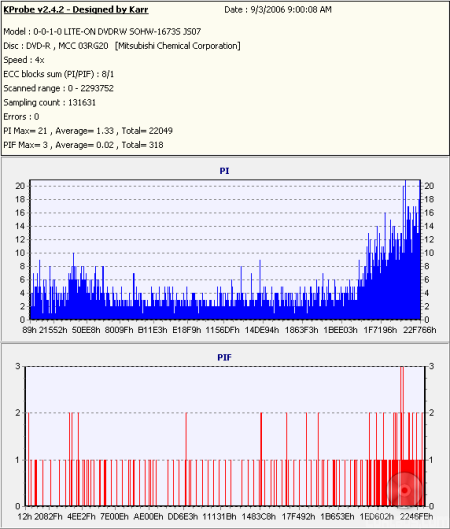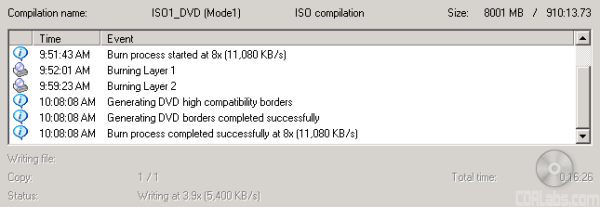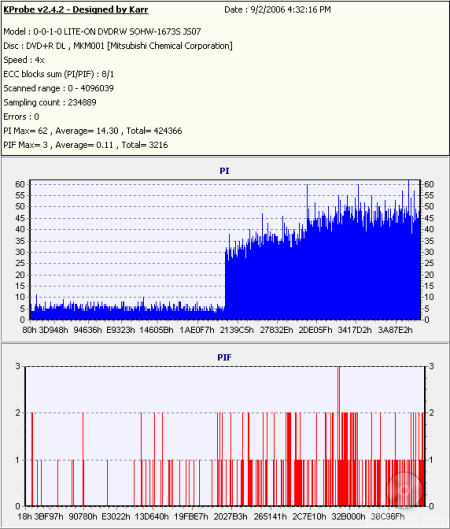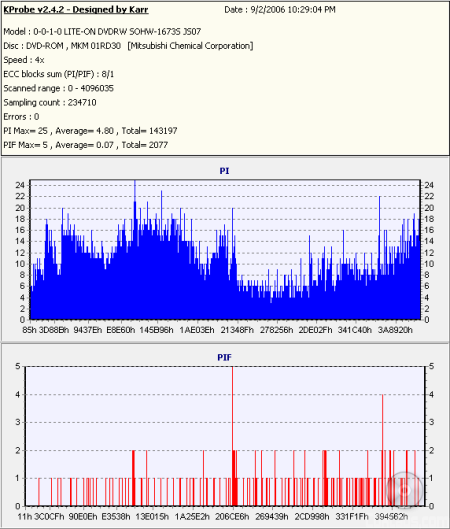

Model: ASUS DRW-1608P3S 16x DVD±RW/RAM
Manufacturer: ASUSTeK Computer, Inc
As one of the biggest names in the computer industry, ASUS doesn't really need much of an introduction. Founded in 1989, this Taiwanese company is one of the world's leading manufacturers of computer components. While best known for their motherboards and video cards, ASUS has shown us that they're pretty serious about optical storage. Over the past few years, they've introduced a number of products for the portable and desktop markets. With their innovative technologies and impressive performance, these drives have been a big hit from the start.

With store shelves already full of DVD writers with similar specs and features, ASUS's new drive is up against some stiff competition. To give you an idea of what to expect from the DRW-1608P3S, we'll take a look at some of its features and then see how it compares to some of the 16x DVD±RW drives from the competition. Does the DRW-1608P3S have what it takes? Is it the best bang for your buck? Read on as we find out.

What's in the box?:
- ASUS DRW-1608P3S 16x DVD±RW/RAM Drive
- Quick Setup Guide
- Nero Software CD
- Ulead Disc Creator CD
- Mounting Screws
Physical Features:
The drive ASUS sent us for this review was manufactured in March of 2006 and had firmware 1.06.For this review the drive's firmware has been updated to version 1.24.
From the front, the DRW-1608P3S looks a lot like ASUS's previous 16x DVD±RW drives, the DRW-1608P and DRW-1608P2. While there are a few slight differences, all three drives share the same basic design and have many of the same logos. Along with the "ASUS" logo on the tray, you can see a few showing support for the DVD+ReWritable and DVD Multi specifications, as well as Ultra Speed CD-RW media.
Below the tray you can see the DRW-1608P3S's single LED. This "BUSY" indicator lights up green whenever the drive is reading or writing.
The rear of the DRW-1608P3S looks very similar to some of the other Pioneer based DVD writers we've reviewed. By looking at the picture below you can see the drive's IDE interface, power connector and analog audio output connector.
Starting from the left of the IDE connection you'll see the jumper switch for master, slave and cable select. By default the drive's jumper comes set to master. Next to the jumper block is the analog audio connector.
Technical Specs:
Most of the specs below have been taken from ASUS's website and the manual that came with the drive.
| ASUS DRW-1608P3S 16x DVD±RW/RAM | |
| CD Write Speeds | 40x (CAV) 32x, 24x (Z-CLV) 16x, 10x, 4x (CLV) |
| CD Rewrite Speeds | 32x, 24x, 20x (Z-CLV) 16x, 10x, 4x (CLV) |
| DVD+R Write Speeds | 16x (CAV) 12x, 8x (Z-CLV) 6x, 4x, 2.4x (CLV) |
| DVD+RW Write Speeds | 8x (Z-CLV) 6x, 4x, 2.4x (CLV) |
| DVD-R Write Speeds | 16x (CAV) 12x, 8x (Z-CLV) 6x, 4x, 2x, 1x (CLV) |
| DVD-RW Write Speeds | 6x, 4x, 2x, 1x (CLV) |
| DVD+R DL Write Speeds | 8x (Z-CLV) 6x, 4x, 2.4x (CLV) |
| DVD-R DL Write Speeds | 8x (Z-CLV) 6x, 4x, 2x (CLV) |
| DVD-RAM Write Speeds | 5x, 3x, 2x (CLV) |
| CD Read Speeds | 40x Max (CD-ROM/CD-R) 32x Max (CD-RW) |
| DAE Speed | 40x Max |
| DVD Read Speeds | 16x Max (DVD-ROM Single Layer) 12x Max (DVD-ROM Dual Layer) 5x Max (DVD-Video) 12x Max (DVD±R) 8x Max (DVD±RW) 8x Max (DVD±R DL) 5x Max (DVD-RAM) |
| Buffer Size | 2MB |
| Access Times |
120 ms (CD-ROM) 130 ms (DVD-ROM) |
| CD Formats | CD-ROM CD-DA CD-Extra Photo CD Video CD CD-Text CD-R CD-RW |
| DVD Formats | DVD-ROM DVD+R/RW DVD-R/RW DVD+R DL DVD-R DL DVD-RAM |
| CD Recording Modes | Disc At Once Track At Once Session At Once Packet Writing Multi-Session |
| DVD+R and DVD+R DL Recording Modes |
Sequential Recording Multi-Session Recording |
| DVD+RW Recording Modes | Random Recording |
| DVD-R and DVD-R DL Recording Modes |
Disc At Once Incremental Recording Multi-Border Recording |
| DVD-RW Recording Modes | Restricted Overwriting Disc At Once Incremental Recording Multi-Border Recording |
The DRW-1608P3S also has many of the same features found on ASUS's other drives, including support for their FlextraLink, FlextraSpeed and DDSS II technologies. More information on these features can be found in our review of the CRW-5224A.
More Features:
By looking at the picture below, you can see that ASUS's new DVD writer is identified as an "ASUS DRW-1608P3S".
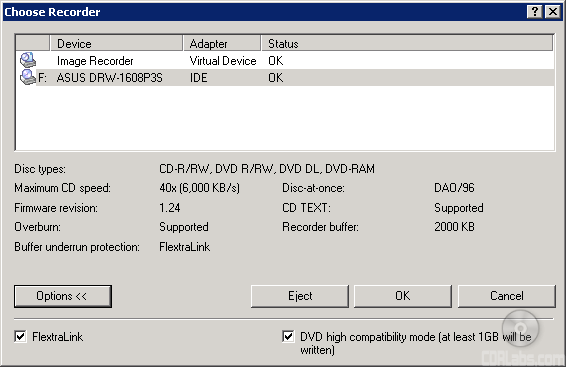
The Nero screenshot also shows that the DRW-1608P3S has a maximum CD writing speed of 40x and a 2000KB buffer. This buffer is also backed up by some form of buffer underrun protection. In this case, it is supposedly ASUS's FlextraLink technology. According to Nero, the drive can also write CD-Text and overburn. When testing the drive's capacity I found that the drive was able to overburn up to 94:27with CompUSA's 99 minute CD-R media.
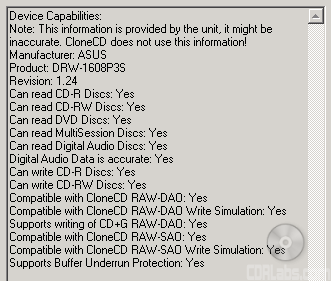
Using Alex Noe's Weak Sector Utility we were able to determine that the DRW-1608P3S is a "two sheep" burner. This means that ASUS's new drive is capable of backing up titles protected by SafeDisc 2, including version 2.51.
Here is a screen shot from Nero's InfoTool. This program queries the drive to see what its reading and writing capabilities are. InfoTool had no problems detecting the DRW-1608P3S's maximum reading and writing speeds, recording modes, buffer underrun protection and 2MB buffer.
InfoTool also shows that the DRW-1608P3S is an RPC-2 DVD drive. This means that the drive's region is stored in the firmware. The drive's region can be changed five times and after that it cannot be changed anymore. A patched RPC-1 firmware can be downloaded here. Just keep in mind that it is not supported by ASUS nor by CDRLabs. Use it at your own risk.
While InfoTool gives us a quick glance at the DRW-1608P3S's features, DVDINFOpro provides a little more information on some of the drive's reading and writing capabilities. By looking at the screenshot above you can see that while ASUS's new drive can read and write to DVD+R DL, DVD-R DL and DVD-RAM media, it does not support the Mt. Rainier format.
The DRW-1608P3S doesn't let you set the book type of single layer DVD+R or DVD+RW media. However, the drive automatically sets the book type for DVD+R DL discs to "DVD-ROM". This greatly reduces compatibility problems, especially with older DVD players.
The DRW-1608P3S's software bundle is very similar to what ASUS included with the DRW-1608P2. The two CD's that come with the drive contain a number of different applications from Nero including Nero Express 6, NeroVision Express 3 SE, Nero Media Player, and InCD as well as Ulead's DVD MovieFactory 4 suite.
Nero Express 6 - With Nero Express, Nero has taken the features and performance people have come to expect from Nero Burning Rom and combined them with a user friendly interface. While the interface has been simplified, Nero Express still supports more advanced features like VCD and DVD creation, CD/DVD duplication, overburning, CD-Text and realtime audio filters.
The version of Nero Express that ASUS included with their new DVD±RW drive is 6.6.0.14d. You can download the latest version of the software from Nero's website.
NeroVision Express 3 SE - NeroVision Express 3 is Nero's video authoring application. Using a user friendly interface very similar to that of Nero Express, NeroVision Express makes it easy for users to capture, edit and then burn their favorite videos to VCD, SVCD or DVD or export it to Nero Digital format.
NeroVision Express also lets users add things like transitions, custom backgrounds, animated menus and text effects. You can even use it to turn your photos into custom slide shows.
Nero Media Player - Nero Media Player features on-the-fly encoding of audio CD's to MP3, HE-AAC, TwinVQ, WMA, and WAV format.The MP3 encoder uses the latest audio codec technology from Fraunhofer.While most of the plugins are unrestricted, the MP3 encoder included with this version of the program is limited to only 30 audio tracks.If you need to encode more you will probably want to upgrade to Nero's NeroMIX.
InCD 4 - InCD is Nero's packet writing software. Like Roxio's Drag-to-Disc or Sonic's DLA, it allows a person to use their CD-RW drive as a big floppy disk. The person can then drag and drop files onto a CD-RW or DVD±RW disc. Many people consider InCD to be one of the best packet writing tools because of its simplicity and performance.
Ulead DVD MovieFactory 4 SE - With Ulead's DVD MovieFactory you can create your own CD's and DVD's quickly and easily. Right from the start, MovieFactory gives you a number of options. From here you can create a new compilation, copy or edit an existing disc, or record video directly to CD or DVD.
Adding movie clips to your current project is as easy as drag and drop. MovieFactory lets you take any MPEG-1, MPEG-2, AVI, VOB or QuickTime video clip and add it to your project. After that you can add your own custom menus, backgrounds, fonts and music or use one of the included templates.
Ulead's MovieFactory will also let you transfer video from your camcorder or TV tuner directly to disc. Just choose your menu template and MovieFactory will capture the video and burn it to CD or DVD automatically.
ASUSTek ASUSDVD - The DRW-1608P3S also comes with ASUS's own DVD playback software, ASUSDVD. Based on CyberLink's PowerDVD, ASUSDVD offers a complete set of navigation commands, including advanced features like multi-angle viewing, dual subtitle display, digital zoom and parental controls.
Along with DVD movies, ASUSDVD can be used to play back your VCD's, SVCD's or whatever video files you might have on your hard drive. Unfortunately, the version of ASUSDVD included with the DRW-1608P3S only supports 2 speaker output. If you want to take advantage of DVD's encoded with DTS or use Dolby Pro Logic II, you'll probably want to pick up a retail copy of PowerDVD or WinDVD.
Like ASUS's previous DVD writers, the DRW-1608P3S offers a good number of features at an affordable price. Along with support for all major DVD formats, it offers some pretty impressive specs. The DRW-1608P3S is capable of 16x DVD±R, 8x DVD+RW, 6x DVD-RW, 5x DVD-RAM writing speeds and a maximum DVD read speed of 16x. On top of that, it can write to both DVD+R DL and DVD-R DL media at 8x. The DRW-1608P3S also includes features like a 2MB buffer, support for ASUS's FlextraLink and FlextraSpeed technologies and a software bundle from Nero and Ulead. Unfortunately, it lacks bitsetting support for single layer DVD+R and DVD+RW media. Even then, the ASUS DRW-1608P3S scores a solid 8 out of 10 for its features.
Like the other ASUS drives I've reviewed, the DRW-1608P3S was very easy to install. From start to finish, the entire process took only a few minutes. I took the drive out of the box, left the jumper set to master and installed it on the secondary IDE chain by connecting the IDE cable and power connector. When I turned on the computer the BIOS detected it as a drive supporting UDMA 66. After making sure that the DMA was enabled in the Device Manager, I was ready to start installing the software.
Software Installation:
As I mentioned earlier, the DRW-1608P3S comes with two CD's full of software. The first of these contains a few different applications from Nero and ASUS. If you have autorun enabled on your computer, the menu pictured below will automatically come up when you insert the disc.
By now most of you should be pretty familiar with this menu. From here you can choose to install Nero 6,NeroVision Express 3 SE, Nero Media Player, or ASUS DVD. Simply click the name of the application you want to install, and its setup program will start up automatically. Once you reboot, you'll be ready to start burning your own discs.
The second disc contains Ulead's DVD MovieFactory 4 suite. Like the other software, the installation process is fairly straightforward. All you need to do is choose what language you want and pick your installation options.By default the setup program will install the entire suite onto your computer. If you don't want to install the entire suite, select the custom installation. From here you can choose the components you want to install.
The Documentation:
Like the DRW-1608P2, the DRW-1608P3S doesn't offer much in the way of documentation. The closest thing to a manual is the drive's "Quick Installation Guide". This small, fold out guide is broken up into 20 different languages with each language getting about a page worth of instructions. While these instructions take the user step by step through the installation process, the small diagrams keep them from being very useful. Also, if you're looking for things like the DRW-1608P3S's specs or system requirements, you'll have to check the back of the box or visit ASUS's website. You won't find that information in the guide.
While ASUS has put a lot of effort into the DRW-1608P3S's features and performance, the documentation could have been better. The brief installation instructions probably won't phase more experienced users, but they might not cut it with those new to upgrading their computer. With this in mind, I give the installation a 7 out of a possible 10.
While CPU, memory, OS and other variables don't often make a huge difference, there are some nonetheless. We have a computer that is used only for testing hardware. We do this so all tests can be compared reliably.
Test System:
| CPU: | AMD Athlon 64 3200+ 2.0GHz | |
| Motherboard: | ASUS K8V SE Deluxe with BIOS 1003 | |
| Memory: | 2 x 256MB Kingston PC3200 | |
| Video Card: | XFX NVIDIA GeForce FX5200 - ForceWare v56.72 | |
| Hard Drive: | Hitachi Deskstar 7K80 80GB SATA 7200RPM | |
| Operating System: | Windows XP SP2 - VIA Hyperion Pro v5.04 |
For DVD writers the performance tests are broken down into four sections: CD read, CD write, DVD read and DVD write tests. Each benchmark test has been run three times. The score given is an average of the three. DMA has been enabled in device manager for all IDE devices supporting it.
CD Read Tests: For the read performance section of the CD-ROM benchmarks, CD WinBench 99 v3.0 and CD Speed v4.51 are used to test read speeds, seek times and CPU usage. For DAE testing both CD Speed and CD DAE are used. CD Speed is used to give an overall DAE speed rating and CD DAE is used to give the track by track extraction speeds and to check the extracted tracks for errors the drive may have created.
CD Write Tests: To test the write speeds, Nero Burning Rom is used to write 650MB and 700MB to our test media. Times are recorded. To test rewrite scores, Nero is used again to time how long it takes to write 400MB of random files and directories. Then Sonic's DLA is used to test packet writing speeds. The same files are copied and pasted in Windows Explorer and timed.
DVD Read Tests: For the read performance section of the DVD benchmarks CD Speed v4.51 is used to test read speeds, seek times, and CPU usage.
DVD Write Tests: To test the DVD write speeds, Nero Burning Rom is used to write 4GB to our test media. Times are recorded. Then Sonic's DLA is used to test packet writing speeds. The same files are copied and pasted in Windows Explorer and timed.
CD Winbench 99 Scores:
| ASUS DRW-1608P3S |
LG GSA-H10N |
Lite-On SHM-165H6S |
NEC ND-4550A |
|
| CD Winbench 99 | 1218 KB/sec | 1190 KB/sec | 1817 KB/sec | 1530 KB/sec |
| Transfer Rate: Inside | 2800 KB/sec | 3183 KB/sec | 2990 KB/sec | 3060 KB/sec |
| Transfer Rate: Outside | 5730 KB/sec | 6350 KB/sec | 6578 KB/sec | 6400 KB/sec |
| Random Access Time | 107ms | 106ms | 106ms | 101ms |
| CPU Utilization | 0.33% | 0.58% | 0.34% | 1.25% |
The CD Winbench test is as close as we can get to testing every day usage. It fires off eight different applications using scripts. This tries to mimic the activities of a person loading these programs onto their own computer.
ASUS's new DVD writer gave us some mixed performance in our CD Winbench tests.In the transfer speed tests, the drive started reading at 18.7x (2800 / 150) and reached a maximum speed of about 38.2x (5730 / 150) on the outside. While this is pretty good for a drive with a maximum read speed of 40x, the DRW-1608P3S's overall score was not as high as some of the other DVD writers we've looked at.
CD Speed v4.51 - Pressed CD:
For this test I used a pressed CD containing one Mode 1 data track. The disc is 74:38 in size and is full of data and directories.
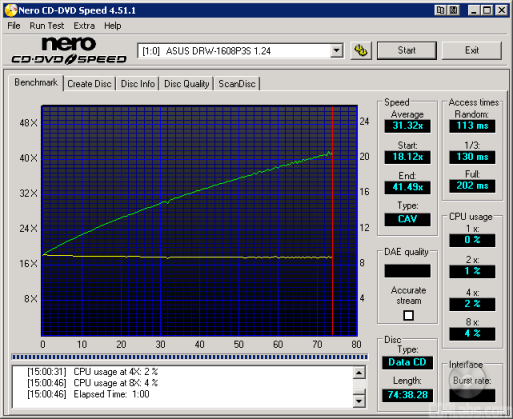
| ASUS DRW-1608P3S |
LG GSA-H10N |
Lite-On SHM-165H6S |
NEC ND-4550A |
|
| Transfer Speed Average: Start: End: |
31.61x 18.12x 41.49x |
35.57x 20.42x 46.78x |
36.68x 21.95x 48.50x |
35.60x 20.54x 47.09x |
| Seek Times Random: 1/3: Full: |
113ms 129ms 202ms |
114ms 130ms 175ms |
103ms 116ms 168ms |
137ms 145ms 219ms |
| CPU Usage 1x: 2x: 4x: 8x: |
0% 1% 2% 4% |
1% 1% 3% 21% |
2% 4% 7% 12% |
17% 1% 3% 6% |
The DRW-1608P3S performed a little better in our CD Speed tests. While still not as fast as the other drives, it had no problems reaching a maximum speed of 41.49x.
CD Speed v4.51 - CD-R Media:
For this test I made a copy of our pressed test CD. I used 12x rated Memorex Gold 74 minute media for the tests.
| ASUS DRW-1608P3S |
LG GSA-H10N |
Lite-On SHM-165H6S |
NEC ND-4550A |
|
| Transfer Speed Average: Start: End: |
31.99x 18.37x 42.48x |
36.30x 20.76x 47.85x |
37.50x 21.74x 49.67x |
36.33x 20.83x 48.03x |
| Seek Times Random: 1/3: Full: |
126ms 136ms 221ms |
113ms 132ms 205ms |
106ms 120ms 184ms |
152ms 159ms 250ms |
| CPU Usage 1x: 2x: 4x: 8x: |
0% 1% 2% 4% |
1% 2% 3% 21% |
2% 5% 8% 13% |
17% 1% 3% 6% |
Like the other drives, the DRW-1608P3S was a little faster when reading CD-R media. While this still wasn't enough to top the other drives, it had no problems reaching a maximum read speed of 42.48x.
ASUS's new DVD writer had no problems recognizing our 99 minute CompUSA media. The drive read our test disc from start to finish, reaching a maximum transfer speed of 43.51x
CD Speed v4.51 - CD-RW Media:
For this test I made a copy of a pressed test CD. I used some PNY 80 minute CD-RW media for the tests.
| ASUS DRW-1608P3S |
LG GSA-H10N |
Lite-On SHM-165H6S |
NEC ND-4550A |
|
| Transfer Speed Average: Start: End: |
25.16x 14.67x 33.23x |
30.58x 17.66x 40.13x |
25.56x 15.01x 33.75x |
30.78x 17.94x 40.13x |
| Seek Times Random: 1/3: Full: |
126ms 142ms 214ms |
112ms 129ms 182ms |
111ms 128ms 190ms |
153ms 161ms 252ms |
| CPU Usage 1x: 2x: 4x: 8x: |
0% 1% 2% 4% |
1% 2% 3% 16% |
3% 6% 12% 21% |
12% 1% 4% 8% |
When reading CD-RW media, the DRW-1608P3S's transfer speeds are limited to only 32x. While ASUS's new writer had no problems reaching this speed in our tests, it was still the slowest out of the four drives here.
CD DAE and CD Speed v4.51 - Pressed CD:
For this test I used Pure Funk. The CD is almost exactly 74 minutes. This helps to squeeze the maximum performance out of the CD.

Exact Audio Copy can tell us a lot about a drive's capabilities. You can see from the screen shot that while ASUS's new DVD writer supports accurate stream and has the ability to cache audio data, it does not have the ability to retrieve C2 error information. This is different than what we saw with InfoTool. If you remember back, it showed that the DRW-1608P3S could return C2 errors.
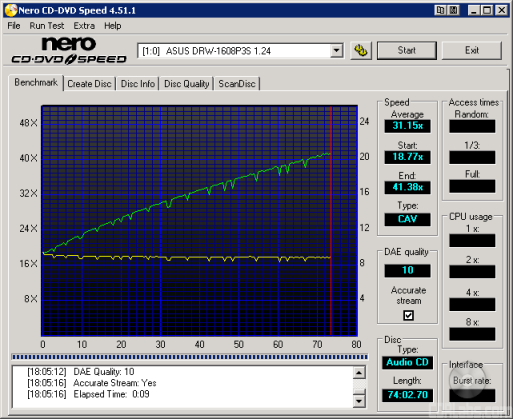
| CD Speed | ASUS DRW-1608P3S |
LG GSA-H10N |
Lite-On SHM-165H6S |
NEC ND-4550A |
| Average: Start: End: DAE Quality: Accurate Stream: |
31.15x 18.77x 41.38x 10 Yes |
30.73x 17.95x 40.68x 10 Yes |
37.03x 21.26x 48.93x 10 Yes |
30.94x 17.99x 40.12x 10 Yes |
The DRW-1608P3S did fairly well in our DAE tests. While not nearly as fast as the drive from Lite-On, it hadno problems ripping pressed audio CD's at 41x.
To get a better look at the quality of the extracted audio we use CD DAE. CD DAE is actually designed to be an audio ripping program. It converts the CD-DA on the CD to .wav files. We use it in our testing because it can also be used as a quick and easy way to test the quality. Where CD Speed tests the DAE as one large session, CD DAE extracts each CD track individually. It actually extracts each track twice and then compares them to check for any errors. Every error a drive creates could be a hiss or pop you would hear later in the audio tracks.
| CD DAE | ASUS DRW-1608P3S |
LG GSA-H10N |
Lite-On SHM-165H6S |
NEC ND-4550A |
| Average: Min: Max: |
29.3x 18.7x 40.1x |
29.0x 18.4x 39.8x |
34.5x 22.3x 47.9x |
29.3x 18.6x 39.5x |
| Errors | 0 | 0 | 0 | 0 |
While the DRW-1608P3S started out fairly quick when extracting our test CD with CD DAE, its average and maximum speeds were slower than what we saw with CD Speed.
CD DAE and CD Speed v4.51 - CD-R Media:
For this test I used a copy of the Pure Funk CD. It's burned onto the same Memorex Gold 74 minute media I used in the CD Speed tests.
| CD Speed | ASUS DRW-1608P3S |
LG GSA-H10N |
Lite-On SHM-165H6S |
NEC ND-4550A |
| Average: Start: End: DAE Quality: Accurate Stream: |
31.14x 18.81x 41.33x 10 Yes |
30.48x 17.94x 40.27x 10 Yes |
36.59x 21.69x 48.24x 10 Yes |
30.67x 17.92x 40.11x 10 Yes |
While the DRW-1608P3S was a little slower when extracting audio from CD-R media, this didn't keep it from reaching amaximum DAE speed of 41x in our tests. So how did it do in CD Speed's advanced DAE tests? Take a look below.

ASUS's new DVD writer completed CD Speed's advanced DAE tests with an average score of 29.62x. The drive had no problems passing all of the on-the-fly tests and did not create any errors. In the advanced features tests, the DRW-1608P3S was able to read the CD-Text and subchannel data but was not able to read the lead in or lead out sections of the CD.
| CD DAE | ASUS DRW-1608P3S |
LG GSA-H10N |
Lite-On SHM-165H6S |
NEC ND-4550A |
| Average: Min: Max: |
29.3x 18.9x 40.0x |
28.8x 18.4x 39.3x |
34.2x 22.3x 47.4x |
29.1x 18.6x 39.5x |
| Errors | 0 | 0 | 0 | 0 |
To see how well ASUS's DVD writer can read scratched and dirty discs, I used CD Speed's ScanDisc utility to see how many sectors were damaged or unreadable. This is a very rough, but good way to test the drive's error correcting abilities.

CD Speed - ScanDisc
The DRW-1608P3S handled scratched discs relatively well. By looking at the screenshot, you can see that the drive considered only 60% of the CD to be "damaged." More importantly, none of the sectors on the disc were unreadable.
You can also get an idea of how well the drive can read scratched and dirty discs by using CD DAE. CD DAE will extract the audio tracks twice and then compare them. From this information we can see what the drive's average speed was and how many errors it generated.
| CD DAE | Avg. Speed | Errors | % of Disc |
|
ASUS DRW-1608P3S |
17.4x | 11131500 | 1.42% |
|
LG GSA-H10N |
28.7x | 37659512 | 4.81% |
|
Lite-On SHM-165H6S |
1.8x | 2069367 | 0.26% |
|
NEC ND-4550A |
8.2x | 167095050 | 21.32% |
Here too, the DRW-1608P3S did pretty well. While the scratches on the disc slowed the drive down slightly, the number of errors was still quite low.
CD Write and ReWrite Tests - Nero Burning Rom 6.6.1.4 andDLA 4.95:
For this test I randomly generated 650MB and 700MB of files and directories to test the time it takes the drive to write and close a CD. All of the files are between 1MB and 25MB in size and no more than 10 directories deep. All of the times below include not only the actual writing time, but the lead in and out times too. This gives a more realistic idea of how long it takes to write a CD.
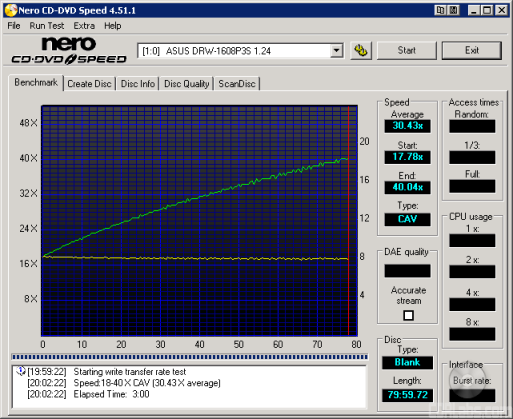
The DRW-1608P3S has a maximum CD writing speed of 40x. To reach this speed, it uses CAV, or Constant Angular Velocity. With Fuji's 48x media, the drive started writing at about 17.78x and reached a maximum speed of 40.10x at the end of the session. This gave ASUS's new DVD±RW an average writing speed of about 30.40x.
To test the drive's writing times, I wrote our test data to some Taiyo Yuden manufactured Fuji media rated at 48x. The results are below.
| Size in MB | Size in Time | ASUS DRW-1608P3S |
LG GSA-H10N |
Lite-On SHM-165H6S |
NEC ND-4550A |
| 651MB | 74:02:55 | 3:07 | 2:58 | 2:32 | 2:57 |
| 701MB | 79:44:21 | 3:33 | 3:05 | 2:44 | 3:03 |
ASUS's new DVD writer went into this test with a slight disadvantage. While the other drives can write CD's at 48x, the DRW-1608P3S has a maximum writing speed of only 40x. Nevertheless, it was able to write an entire 650MB CD in a respectable 3:07.
To test the drive's writing quality I used Lite-On IT's KProbe2. Written by Karr Wang, this utility can be used to test the number of C1 and C2 errors on a disc. For these tests I used a Lite-On LTR-52246S (firmware 6S0F) and read the discs at 32x.
The DRW-1608P3S's writing quality is very good. By looking at the KProbe screenshots, you can see that the discs burned by the drive had a low number of C1 errors and there were no C2 errors at all.
For the rewriting tests I created 400MB of files on the hard drive and wrote them in DAO mode using Nero. To test the packet writing speeds I copied and pasted the same files off the hard drive onto a CD-RW disc using DLA from Sonic. Verbatim's 32x Ultra Speed CD-RW media was used for these tests.
While the DRW-1608P3S uses CAV when writing to CD-R discs, it uses Z-CLV, or Zone CLV, when rewriting at 32x. By looking at the screenshot above, you can see that it starts writing at 16x and jumps to 24x at about the 19 minute mark. The drive writes at this speed until about the 49 minute mark. At this point, the writing speed increases to 32x and stays there until the very end of the session.
| Software | ASUS DRW-1608P3S |
LG GSA-H10N |
Lite-On SHM-165H6S |
NEC ND-4550A |
| Nero | 2:52 | 2:14 | 2:37 | 2:04 |
| DLA Write | 2:40 | 2:12 | 2:39 | 1:59 |
| DLA Read | 5:21 | 1:16 | 1:41 | 1:12 |
With its Z-CLV writing method, the DRW-1608P3S wasn't as fast as some of the other DVD writers we've looked at. In our tests, ASUS's new drive took 2:52 to write 400MB with Nero and 2:40 to do the same with DLA. Unfortunately, it was even slower when reading back our test data. The DRW-1608P3S took more than 5 minutes to read back all 400MB of files and directories.
| ASUS DRW-1608P3S |
LG GSA-H10N |
Lite-On SHM-165H6S |
NEC ND-4550A |
|
| Quick Erase | 22 seconds | 15 seconds | 26 seconds | 29 seconds |
| Full Erase | 3:46 | 3:08 | 3:58 | 3:11 |
The DRW-1608P3S also erases at 32x. While it didn't have the fastest full erase time out of the four drives here, it was able to do a quick erase in only 22 seconds.
Nero CD Speed v4.51 - DVD-ROM:
A little editorial note here. Like a CD-ROM, you will get different benchmark results depending on what kind of discs you are using. You are probably going to get varying results from a full data disc to a single layer movie disc. You're also going to get different results for single and dual layer discs.
The CD Speed website recommends using a single layer DVD-ROM disc with a capacity of at least 4GB. If you use a dual layer disc you probably won't get the best results because most DVD-ROM drives slow down to read them. Some even slow down to read single layer DVD-Video discs. To make a long story short, I am using a 4.37GB single layer, single sided disc for this test.
| ASUS DRW-1608P3S |
LG GSA-H10N |
Lite-On SHM-165H6S |
NEC ND-4550A |
|
| Transfer Speed Average: Start: End: |
12.01x 6.65x 16.11x |
12.31x 6.80x 16.46x |
12.11x 6.45x 16.20x |
11.94x 6.57x 15.97x |
| Seek Times Random: 1/3: Full: |
117ms 140ms 218ms |
103ms 120ms 187ms |
115ms 135ms 213ms |
136ms 148ms 226ms |
| CPU Usage 1x: 2x: 4x: 8x: |
4% 8% 15% 48% |
6% 11% 22% 42% |
9% 9% 20% 96% |
15% 15% 28% 52% |
The DRW-1608P3S performed pretty well when reading single layer DVD-ROM's. In our tests it started reading at 6.65x and reached a maximum transfer speed of about 16.11x.
Nero CD Speed v4.51 - DVD-R and DVD-RW:
First, we'll look at the drive's DVD-R and DVD-RW reading performance. For this I made copies of our DVD-ROM test disc using some general use 4x DVD-R and 2x DVD-RW media from Verbatim and then ran our usual DVD read tests with CD Speed. For the DVD-RAM tests, media from Maxell was used. The results are below.
Verbatim DVD-R
| ASUS DRW-1608P3S |
LG GSA-H10N |
Lite-On SHM-165H6S |
NEC ND-4550A |
|
| Transfer Speed Average: Start: End: |
9.38x 5.20x 12.51x |
12.35x 6.83x 16.52x |
9.20x 5.04x 12.29x |
11.97x 6.60x 16.01x |
| Seek Times Random: 1/3: Full: |
116ms 13ms 220ms |
108ms 125ms 176ms |
125ms 136ms 229ms |
135ms 156ms 248ms |
| CPU Usage 1x: 2x: 4x: 8x: |
5% 9% 17% 56% |
6% 11% 22% 42% |
5% 8% 25% n/a |
16% 17% 31% 62% |
Verbatim DVD-RW
| ASUS DRW-1608P3S |
LG GSA-H10N |
Lite-On SHM-165H6S |
NEC ND-4550A |
|
| Transfer Speed Average: Start: End: |
6.26x 3.45x 8.37x |
10.03x 5.55x 13.40x |
9.20x 5.05x 12.30x |
9.81x 5.40x 13.12x |
| Seek Times Random: 1/3: Full: |
115ms 138ms 225ms |
128ms 150ms 217ms |
110ms 120ms 202ms |
124ms 154ms 251ms |
| CPU Usage 1x: 2x: 4x: 8x: |
5% 9% 19% 39% |
6% 11% 22% 57% |
5% 9% 27% n/a |
9% 15% 28% 50% |
ASUS's new drive had no problems reading DVD-R and DVD-RW media. In our tests, it was able to read DVD-R media at a respectable 12.5x, but reached a maximum transfer speed of only 8.3x when reading DVD-RW discs.
Verbatim DVD-R DL
| ASUS DRW-1608P3S |
LG GSA-H10N |
Lite-On SHM-165H6S |
NEC ND-4550A |
|
| Transfer Speed Average: Start: End: |
5.70x 3.18x 7.60x |
9.27x 5.16x 12.36x |
6.05x 3.37x 8.06x |
5.47x 3.04x 7.29x |
| Seek Times Random: 1/3: Full: |
115ms 142ms 224ms |
132ms 156ms 220ms |
124ms 130ms 221ms |
211ms 221ms 316ms |
| CPU Usage 1x: 2x: 4x: |
4% 8% n/a |
6% 12% 43% |
6% 9% n/a |
8% 13% n/a |
The DRW-1608P3S wasn't as fast when reading Verbatim's 4x DVD-R DL media. As you can see, the drive started reading at 3.18x and reached a maximum transfer speed of 7.60x.
Maxell 5x DVD-RAM
| ASUS DRW-1608P3S |
LG GSA-H10N |
Lite-On SHM-165H6S |
NEC ND-4550A |
|
| Transfer Speed Average: Start: End: |
4.98x 4.96x 5.01x |
10.26x 5.90x 12.07x |
4.64x 2.99x 5.00x |
4.99x 4.94x 5.01x |
| Seek Times Random: 1/3: Full: |
180ms 2ms 3ms |
199ms 173ms 197ms |
125ms 137ms 274ms |
207ms 195ms 311ms |
| CPU Usage 1x: 2x: 4x: |
35% 56% 53% |
7% 12% 21% |
6% 14% 25% |
7% 13% 24% |
ASUS's new drive has a maximum transfer speed of 5x when reading DVD-RAM discs. By looking at the screenshot, you can see that it reads at this speed from start to finish. For whatever reason, the 1/3 and full seek times were much lower than they should have been and the CPU usage was abnormally high.
Nero CD Speed v4.51 - DVD+R and DVD+RW:
Next we'll look at the drive's DVD+R and DVD+RW reading performance. For this I made a copy of our DVD-ROM test disc using some 4x DVD+R and 2.4x DVD+RW media from Verbatim. I then ran our usual DVD read tests with CD Speed. The results are below.
Verbatim DVD+R
| ASUS DRW-1608P3S |
LG GSA-H10N |
Lite-On SHM-165H6S |
NEC ND-4550A |
|
| Transfer Speed Average: Start: End: |
9.37x 5.20x 12.54x |
12.33x 6.80x 16.50x |
9.17x 5.09x 12.27x |
11.96x 6.60x 16.00x |
| Seek Times Random: 1/3: Full: |
119ms 139ms 220ms |
107ms 127ms 185ms |
101ms 109ms 185ms |
133ms 154ms 250ms |
| CPU Usage 1x: 2x: 4x: 8x: |
5% 8% 16% 64% |
6% 12% 22% 42% |
10% 7% 25% n/a% |
16% 17% 34% 65% |
Verbatim DVD+RW
| ASUS DRW-1608P3S |
LG GSA-H10N |
Lite-On SHM-165H6S |
NEC ND-4550A |
|
| Transfer Speed Average: Start: End: |
6.26x 3.45x 8.37x |
10.03x 5.54x 13.39x |
9.22x 5.11x 12.33x |
9.81x 5.40x 13.12x |
| Seek Times Random: 1/3: Full: |
115ms 131ms 216ms |
128ms 149ms 215ms |
106ms 122ms 195ms |
128ms 160ms 258ms |
| CPU Usage 1x: 2x: 4x: 8x: |
5% 8% 18% 38% |
6% 12% 22% 51% |
8% 10% 29% n/a |
11% 21% 34% 64% |
The DRW-1608P3S's performance with DVD+R and DVD+RW media was very similar to what we saw with DVD-R and DVD-RW media. The drive read DVD+R discs at 12.5x and DVD+RW media at 8.3x.
Verbatim DVD+R DL
| ASUS DRW-1608P3S |
LG GSA-H10N |
Lite-On SHM-165H6S |
NEC ND-4550A |
|
| Transfer Speed Average: Start: End: |
5.70x 3.18x 7.61x |
9.27x 5.16x 12.38x |
6.05x 3.37x 8.07x |
5.47x 3.04x 7.30x |
| Seek Times Random: 1/3: Full: |
126ms 132ms 218ms |
130ms 151ms 218ms |
111ms 124ms 187ms |
148ms 185ms 294ms |
| CPU Usage 1x: 2x: 4x: |
4% 8% n/a |
6% 11% 30% |
6% 8% n/a |
7% 12% n/a |
Reading Verbatim's double layer DVD+R media wasn't a problem for the DRW-1608P3S either. While not nearly as fast as the drive from LG, it reached a maximum transfer speed of 7.61x.
Nero CD Speed v4.51 - DVD-Video:
For these tests I am using the US version of Transformers: The Movie on DVD. The disc is over 4GB and single sided.
| ASUS DRW-1608P3S |
LG GSA-H10N |
Lite-On SHM-165H6S |
NEC ND-4550A |
|
| Transfer Speed Average: Start: End: |
3.89x 2.14x 5.02x |
3.65x 2.02x 4.88x |
11.99x 6.62x 16.04x |
11.83x 6.49x 15.82x |
| Seek Times Random: 1/3: Full: |
107ms 123ms 205ms |
121ms 147ms 219ms |
114ms 122ms 197ms |
135ms 147ms 228ms |
| CPU Usage 1x: 2x: 4x: 8x: |
5% 8% 20% 57% |
6% 11% 21% n/a |
7% 10% 20% 97% |
15% 15% 28% 51% |
The DRW-1608P3S didn't do as well as some of the other drives when reading DVD videos. In our tests, it reached a maximum speed of only 5x when reading both single and dual layer discs. This is pretty slow considering there are drives out there that can reach speeds as high as 16x.
To see how well the DRW-1608P3S worked as a DVD player, I watched a few scenes from Transformers: The Movie and Star Wars: The Phantom Menace using WinDVD 4 and PowerDVD 5. The drive had no problems playing back these movies with either program and was fairly quiet.
DVD Write and ReWrite Tests - Nero Burning Rom 6.6.1.4 andDLA 4.95:
To test the DVD writing performance of ASUS's new drive I used Verbatim 16x DVD+R, 16x DVD-R, 8x DVD+RW and 6x DVD-RW media. To get the writing times, a 4.38GB image was burned to our test discs using Nero.
When writing to DVD+R and DVD-R media at 16x, the DRW-1608P3S uses CAV. By looking at the screenshots above, you can see that ASUS's new drive starts writing at about 6.7x and accelerates, reaching its maximum speed as it reaches the end of the disc.
The DRW-1608P3S also features 8x DVD+RW and 6x DVD-RW writing speeds. While the drive uses CLV when writing to DVD-RW media, it uses Z-CLV to reach its maximum DVD+RW writing speed.
| ASUS DRW-1608P3S |
LG GSA-H10N |
Lite-On SHM-165H6S |
NEC ND-4550A |
|
| DVD+R | 6:16 | 5:38 | 6:07 | 6:10 |
| DVD-R | 6:01 | 5:32 | 6:16 | 6:06 |
| DVD+RW | 7:28 | 7:25 | 8:08 | 7:16 |
| DVD-RW | 10:10 | 9:59 | 10:37 | 10:34 |
The DRW-1608P3S performed pretty well in our DVD writing tests. While not as fast as some of the other drives when writing to DVD+R discs at 16x, it turned in some fairly good times with DVD-R, DVD+RW and DVD-RW media.
To check the media compatibility of the DRW-1608P3S, I ran a few tests using some of the media available in my area. The media types, along with the average time it took the drive to write our 4.38GB image, are listed below.
| Manufacturer ID | Max Write Speed |
Average Write Time |
|
| Taiyo Yuden 8x DVD+R | YUDEN000T02 | 12x | 7:37 |
| Daxon 16x DVD+R | DAXONAZ3 | 16x | 6:17 |
| Memorex 16x DVD+R | RICOHJPN R03 | 12x | 7:33 |
| Optodisc 16x DVD+R | OPTODISCR16 | 12x | 7:37 |
| RiDATA 16x DVD+R | RITEKR04 | 12x | 7:30 |
| Verbatim 16x DVD+R | MCC-004 | 16x | 6:16 |
| Daxon 16x DVD-R | DAXON016S | 16x | 6:03 |
| Memorex 16x DVD-R | CMC MAG.AM3 | 16x | 6:04 |
| Optodisc 16x DVD-R | OPTODISCR016 | 16x | 6:02 |
| RiDATA 16x DVD-R | RITEKF1 | 16x | 7:42 |
| Taiyo Yuden 16x DVD-R | TYG03 | 16x | 6:00 |
| Verbatim 16x DVD-R | MCC 03RG20 | 16x | 6:01 |
So what about writing quality? Testing a drive's DVD writing quality isn't easy. Until now, there were very few options, unless you wanted to shell out thousands of dollars for a certified test machine. Thanks to KProbe, we can test a disc's PI (Parity Inner) and PIF (Parity Inner Fail) rates.For these tests I used a Lite-On SOHW-1673S and read the discs at 4x with the PI and PIF ECC sums set to 8 and 1 respectively. For comparison, I also tested the discs on a BenQ DW1640. When combined with Nero CD Speed, the DW1640 is able to report PI Errors, PI Failures, Parity Outer Failures and even jitter levels. For this test, the discs are read at 8x with both the PI and PIF ECC sums set to 8.
So what are "good" results supposed to look like? With KProbe, the PI errors should not exceed 280 and the number of PIF errors should stay below 4. When testing with CD Speed, the number of PI errors should stay below 280 as well. However, because it scans with an ECC sum of 8, a higher number of PIF errors is acceptable, as long as they do not exceed 32. Since POF errors are uncorrectable, we really don't want to see any of them at all.
I also put these discs through a "stress test" by reading them back at 16x with the DW1640. By reading these discs back at this speed, we can see if there are any readability issues caused by the number of errors or high levels of jitter.
|
|
|
||||||||||||||||||||||||||||||||||||||||||||||||||||||||||||||||||||||||
|
|
|
||||||||||||||||||||||||||||||||||||||||||||||||||||||||||||||||||||||||
The DRW-1608P3S's writing quality was pretty good with most of the DVD+R media we tested. Aside from a few small spikes, the PI/PIF rates stayed within acceptable limits. The only real exception being Optodisc's 16x DVD+R media. When scanned with the BenQ DW1640, the PI/PIF rates jumped up considerably near the end.
|
|
|
||||||||||||||||||||||||||||||||||||||||||||||||||||||||||||||||||||||||
|
|
|
||||||||||||||||||||||||||||||||||||||||||||||||||||||||||||||||||||||||
Lastly, here are some results from our DVD-R test media. While the writing quality varied from one manufacturer to another, the results were pretty good for the most part.
| ASUS DRW-1608P3S |
LG GSA-H10N |
Lite-On SHM-165H6S |
NEC ND-4550A |
|
| DVD+RW Quick | 5 seconds | 10 seconds | 10 seconds | 10 seconds |
| DVD+RW Full | 7:20 | 7:18 | 8:10 | 7:19 |
| DVD-RW Quick | 1:12 | 27 seconds | 1:02 | 36 seconds |
| DVD-RW Full | 10:38 | 9:57 | 10:57 | 14:20 |
To test the DRW-1608P3S's packet writing performance I used DLA 4.95. Verbatim 8x DVD+RW, Verbatim 6x DVD-RW and Maxell 5x DVD-RAM media were used once again.
| ASUS DRW-1608P3S |
LG GSA-H10N |
Lite-On SHM-165H6S |
NEC ND-4550A |
|
| DVD+RW Write | 6:31 | 6:31 | 7:19 | 6:29 |
| DVD+RW Read | 8:30 | 7:19 | 9:01 | 14:39 |
| DVD-RW Write | 8:23 | 8:24 | 9:06 | 12:13 |
| DVD-RW Read | 8:57 | 8:42 | 6:45 | 6:10 |
| DVD-RAM Write | 25:56 | 13:56 | 28:55 | 27:26 |
| DVD-RAM Read | 10:20 | 6:51 | 11:22 | 10:28 |
The DRW-1608P3S performed pretty well in our packet writing tests. While no match for the GSA-H10N when reading and writing to DVD-RAM discs, it turned in some fairly good times with DVD-RW and DVD+RW media.
Double Layer DVD Write Tests - Nero Burning Rom 6.6.1.4:
To test the double layer DVD writing performance of the DRW-1608P3S, I used DVD+R DL and DVD-R DL media from Verbatim and RiDATA. I created about 8GB of random files and directories on my hard drive and then burned them to our test discs with Nero.
The DRW-1608P3S had no problems writing to Verbatim's 8x and 2.4x DVD+R DL media at 8x. Unfortunately, the discs from RiDATA would not work at anything faster than 2.4x.
| ASUS DRW-1608P3S |
LG GSA-H10N |
Lite-On SHM-165H6S |
NEC ND-4550A |
|
| DVD+R DL Write | 16:26 | 14:14 | 17:22 | 18:36 |
While no match for the drive from LG, the DRW-1608P3S took 16:26 to write 8001MB of data. So what about writing quality? Take a look below.
|
|
|
||||||||||||||||||||||||||||||||||||||||||||||||||||||||||||||||||||||||
The writing quality wasn't as good as I had expected with Verbatim's DVD+R DL media. In both cases, the error rate started out fairly low but jumped up considerably on the second layer. RiDATA's DVD+R DL media didn't fair any better. While written at a slower speed, the PI/PIF rates were fairly high at the layer change. Surprisingly enough, this didn't seem to have any effect on readability.
The DRW-1608P3S also features 8x DVD-R DL writing speeds. To test the drive's writing times, Verbatim's 4x DVD-R DL media was used.
| ASUS DRW-1608P3S |
LG GSA-H10N |
Lite-On SHM-165H6S |
NEC ND-4550A |
|
| DVD-R DL Write | 16:56 | 19:12 | 28:04 | 20:42 |
The DRW-1608P3S had no problems taking the top spot in this test. Thanks to its 8x DVD-R DL writing speed, it took the drive only 16:56 to write 8001MB of data. So what about writing quality? Take a look below.
|
|
||||||||||||||||||||||||||||||||||||||||||||||||
The DRW-1608P3S's writing quality was pretty good with Verbatim's 4x DVD-R DL media. The error rates stayed within acceptable limits when tested with both KProbe and CD Speed and there were no readability problems. Unfortunately, the results weren't as good with RiDATA's DVD-R DL media. The PI/PIF rates were not only high, there were a number of PO Failures. As you can see, this caused a large dip in the transfer rate graph.
Performance Revisited:
For the most part, the DRW-1608P3S performed as expected. The drive had no problems holding its own in our DVD writing tests, turning some respectable times with DVD±R, DVD±RW and DVD±R DL media. Reading DVD's wasn't a problem for ASUS's new drive either. The DRW-1608P3S was able to read single layer data DVD's at 16x and DVD±R media at 12x, but slowed to only 5x when reading DVD videos.
The DRW-1608P3S also did relatively well in our CD read tests. While the drive's seek times were a little on the high side, it had no problems reading all types of media at its rated speeds. When it came to writing CD's, the DRW-1608P3S's 40x CD-R writing speed put it at a slight disadvantage. Nevertheless, its writing quality was very good. With all things considered, the ASUS DRW-1608P3S gets an 8 out of 10 for the performance section of this review.
Over the last few years, we've taken a look at a number of ASUS's DVD writers. While many of them impressed us, others didn't perform as well as we would have liked. Fortunately, the DRW-1608P3S falls into the first category rather than the latter. Based on the Pioneer DVR-111, ASUS's new drive offers a good mix of performance and features at an affordable price.
Like its Pioneer counterpart, the DRW-1608P3S can write to DVD+R and DVD-R media at 16x. At this speed, it took the drive a little more than 6 minutes to write an entire 4.7GB DVD. ASUS's new DVD writer also did pretty well in our rewriting tests, turning in some respectable times with DVD-RW, DVD+RW and DVD-RAM media. Most impressive though was the DRW-1608P3S's DVD±R DL writing performance. Thanks to its 8x writing speed, the drive took less than 17 minutes to burn an entire 8.5GB DVD.
When it came to media compatibility, the DRW-1608P3S gave us some mixed results. While the drive wrote to all of our DVD-R media at its rated speeds, finding DVD+R discs that would work at 16x was not an easy task. In most cases, the writing speed was limited to only 12x. On the other hand, the DRW-1608P3S's writing quality was, for the most part, pretty good. However, there's still room for improvement, especially with Optodisc 16x DVD+R and RiDATA DVD-R DL media. Hopefully ASUS can tweak this in a future firmware update.
The DRW-1608P3S also performed relatively well in our DVD read tests. Along with some fairly good seek times, the drive was able to read single layer DVD-ROM's at 16x, DVD±R discs at 12x and both DVD±RW and DVD±R DL media at a respectable 8x. Unfortunately, the DRW-1608P3S slowed to only 5x when reading DVD-Videos. While this doesn't have any effect on movie playback, there are better drives out there if you want to rip DVD movies.
Reading and writing CD's wasn't a problem for the DRW-1608P3S either. In our tests, the drive read pressed and CD-R media at speeds as high as 41x and CD-RW discs at 32x. It also did fairly well when ripping audio CD's, reaching DAE speeds as high as 41x. As a writer, the DRW-1608P3S performed as expected. While the drive's 40x CD-R writing speed did put it at a disadvantage in some of our tests, its writing quality was very good.
When it comes to features, the DRW-1608P3S is very similar to ASUS's previous DVD writers. Along with a 2MB buffer, the drive supports things like ASUS's FlextraLink, FlextraSpeed and DDSS II technologies. The DRW-1608P3S also offers a good number of writing and rewriting speeds to choose from and automatically sets the book type when writing to DVD+R DL discs. Unfortunately, it won't let you do the same with DVD+R or DVD+RW media. Last but not least, ASUS has included a great software software bundle from Nero and Ulead.
In the end, it usually comes down to price. Fortunately, the DRW-1608P3S is one of the more affordable 16x DVD±RW drives currently available. Available in your choice of black, silver or beige, the retail version of the drive can be picked up for less than $50 through some of the online vendors found on Pricegrabber.
| ASUS DRW-1608P3S 16x DVD±RW/RAM |
|
| Features: Installation: Performance: |
8 7 8 |
| Overall: | 8 |
Highs:
- Writes to DVD-R and DVD+R media at 16x
- Writes to DVD+RW media at 8x
- Writes to DVD-RW media at 6x
- Writes to DVD+R DL and DVD-R DL media at 8x
- Reads single layer DVD-ROM's at 16x
- Reads DVD±R media at 12x
- Reads DVD±RW and DVD±R DL media at 8x
- Reads and writes to DVD-RAM media at 5x
- Features 40x CD-R and 32x CD-RW writing speeds
- Good selection of writing and rewriting speeds
- Supports ASUS's FlextraLink, FlextraSpeed and DDSS II technologies
- Automatically sets book type to DVD-ROM for DVD+R DL media
- Includes software from Nero, Ulead and ASUS
- Affordably priced
Lows:
- Reads DVD videos at only 5x
- Cannot set the book type of DVD+R or DVD+RW media
- Documentation could be better
- Only a 2000KB buffer
- No digital audio output
- Overburns to only 94:27




